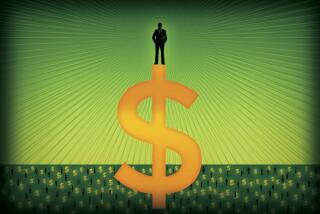Salaries for Top Auto Executives Declined in ’89 : Workplace: An industry slump forced a million-dollar pay cut in one case. The UAW called the payments ‘a disease still in need of a cure.’
- Share via
DETROIT — The chairmen of General Motors Corp. and Ford Motor Co. took sharp pay cuts in 1989 during an auto industry slump but still received more than $9 million between them, the companies said Monday.
Ford Chairman Donald E. Petersen received $6.6 million in salary, bonuses and stock options last year, down from $10.5 million in 1988, the No. 2 auto maker said in its annual proxy statement.
GM Chairman Roger B. Smith was paid $2.5 million, down from $3.6 million the previous year, the proxy for the world’s largest auto maker revealed.
The payouts were the last for a full year for the two executives. Petersen retired March 1 as Ford’s chairman and chief executive, while Smith steps down at the end of July.
The United Auto Workers union called the payments “a disease that’s still in need of a cure.”
“The auto industry has real and pressing problems, but the companies signal only arrogance and business-as-usual attitudes through these excessive payments to senior executives,” UAW President Owen Bieber and the union’s GM and Ford department heads said in a statement.
GM President Robert C. Stempel, who takes over Aug. 1 as chairman, received $1.8 million in compensation last year. More than half of the compensation received by Smith and Stempel was in stock options.
Ford’s new chairman, Harold A. Poling, received $2.9 million for 1989, about $2.1 million in salary and bonuses and the rest in stock options.
Chrysler Corp. on Friday is expected to release its proxy statement.
The auto industry is mired in a slump reflected by 1989 profits, when Big Three earnings fell 25% from 1988.
GM profits declined 13% to $4.22 billion, Ford’s dropped 28% to $3.84 billion and Chrysler’s tumbled 66% to $359 million.
Ford’s proxy statement showed that Petersen received $3.1 million in salary and bonuses and $3.5 million on stock options last year.
His 1989 compensation was 37% less than in 1988, when he was the auto industry’s top-paid executive. At GM, Smith’s earnings declined about 31%.
Three other officers listed separately in Ford’s proxy, President Philip Benton and executive vice presidents Allan Gilmour and Louis Ross, received more than $1.7 million apiece.
Collectively, Ford awarded about $214 million to 5,286 Ford executives in bonuses for the company’s performance in 1989.
According to a formula, Ford could have distributed $229 million in bonuses. The board reduced that, leaving $1.3 million in the bonus pool for 1990 and transferring $14.4 million into general operating coffers.
About 150,000 hourly Ford workers last month received profit-sharing checks of about $1,025 each. GM paid an average of $50 to about 443,000 employees.






